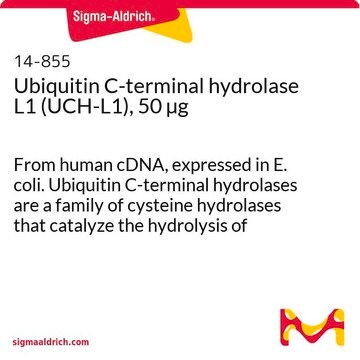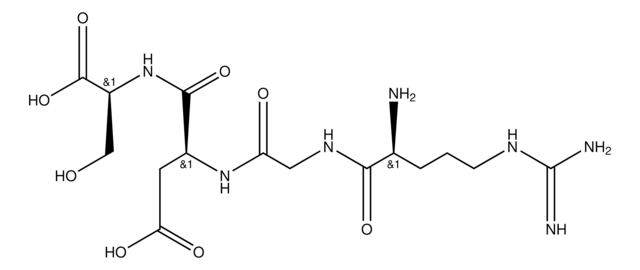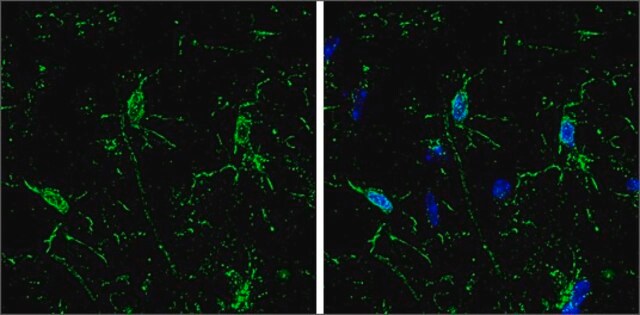14-856
Ubiquitin C-terminal hydrolase L3 (UCH-L3), 50 µg
From human cDNA, expressed in E. coli. Ubiquitin C-terminal hydrolases are a family of cysteine hydrolases that catalyze the hydrolysis of amides, esters & thioesters of the C-terminus of ubiquitin.
Anmeldenzur Ansicht organisationsspezifischer und vertraglich vereinbarter Preise
Alle Fotos(1)
About This Item
UNSPSC-Code:
12352200
eCl@ss:
32160405
NACRES:
NA.32
Empfohlene Produkte
Biologische Quelle
human
Qualitätsniveau
Rekombinant
expressed in E. coli
Spezifische Aktivität
>1000 pmol/min-μg, 25 °C (with 1 μM ubiquitin-AMC as substrate and UCH-L3 at 20 pM (0.58 ng/mL).)
Mol-Gew.
Mw 26.2 kDa
Hersteller/Markenname
Upstate®
NCBI-Hinterlegungsnummer
UniProt-Hinterlegungsnummer
Versandbedingung
dry ice
Allgemeine Beschreibung
Produced from human cDNA, expressed in E. coli. Ubiquitin C-terminal hydrolases (UCHs) are a family of cysteine hydrolases that catalyze the hydrolysis of amides, esters and thioesters of the C-terminus of ubiquitin. UCH-L3 is a member of the lower molecular weight group of UCHs involved in the hydrolysis of small C-terminal derivatives of ubiquitin that form non-specifically during the process of protein ubiquitinylation.
Product Source: Recombinant human UCH-L3 expressed in E.coli.
Anwendung
From human cDNA, expressed in E. coli. Ubiquitin C-terminal hydrolases are a family of cysteine hydrolases that catalyze the hydrolysis of amides, esters & thioesters of the C-terminus of ubiquitin.
Lagerung und Haltbarkeit
Store at -70°C for up to 12 months from date of receipt. As supplied, the enzyme is stable on ice for several hours. Activity is stable up to 6 freeze/thaw cycles (snap freezing in a dry/ice ethanol bath or liquid nitrogen).
Rechtliche Hinweise
UPSTATE is a registered trademark of Merck KGaA, Darmstadt, Germany
Haftungsausschluss
Unless otherwise stated in our catalog or other company documentation accompanying the product(s), our products are intended for research use only and are not to be used for any other purpose, which includes but is not limited to, unauthorized commercial uses, in vitro diagnostic uses, ex vivo or in vivo therapeutic uses or any type of consumption or application to humans or animals.
Lagerklassenschlüssel
12 - Non Combustible Liquids
WGK
WGK 1
Flammpunkt (°F)
Not applicable
Flammpunkt (°C)
Not applicable
Analysenzertifikate (COA)
Suchen Sie nach Analysenzertifikate (COA), indem Sie die Lot-/Chargennummer des Produkts eingeben. Lot- und Chargennummern sind auf dem Produktetikett hinter den Wörtern ‘Lot’ oder ‘Batch’ (Lot oder Charge) zu finden.
Besitzen Sie dieses Produkt bereits?
In der Dokumentenbibliothek finden Sie die Dokumentation zu den Produkten, die Sie kürzlich erworben haben.
K D Wilkinson et al.
Journal of molecular biology, 291(5), 1067-1077 (1999-10-16)
The ubiquitin fold is a versatile and widely used targeting signal that is added post-translationally to a variety of proteins. Covalent attachment of one or more ubiquitin domains results in localization of the target protein to the proteasome, the nucleus
Shahram Misaghi et al.
The Journal of biological chemistry, 280(2), 1512-1520 (2004-11-09)
Ubiquitin C-terminal hydrolases (UCHs) comprise a family of small ubiquitin-specific proteases of uncertain function. Although no cellular substrates have been identified for UCHs, their highly tissue-specific expression patterns and the association of UCH-L1 mutations with human disease strongly suggest a
Roles of ubiquitinylation in proteolysis and cellular regulation
Wilkinson, K D
Annual Review of Nutrition, 15, 161-189 (1995)
L J Kurihara et al.
Molecular and cellular biology, 20(7), 2498-2504 (2000-03-14)
Mice homozygous for the s(1Acrg) deletion at the Ednrb locus arrest at embryonic day 8.5. To determine the molecular basis of this defect, we initiated positional cloning of the s(1Acrg) minimal region. The mouse Uch-L3 (ubiquitin C-terminal hydrolase L3) gene
Kinetic and mechanistic studies on the hydrolysis of ubiquitin C-terminal 7-amido-4-methylcoumarin by deubiquitinating enzymes.
Dang, L C, et al.
Biochemistry, 37, 1868-1879 (1998)
Unser Team von Wissenschaftlern verfügt über Erfahrung in allen Forschungsbereichen einschließlich Life Science, Materialwissenschaften, chemischer Synthese, Chromatographie, Analytik und vielen mehr..
Setzen Sie sich mit dem technischen Dienst in Verbindung.






